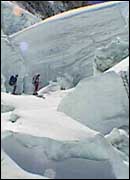 [click to zoom] (photo: Burleson/ Alpine Ascents) |
The constantly shifting Khumbu Icefall, the first part of the classic southern route on Everest, is like a massive jumble of ice cubes slowly tumbling down the mountain. These huge chunks of ice (called seracs) are more likely to freeze in place at night and come crashing down when warmed in the sun, though really, it can and does happen at any time. The impossibility of predicting when a part of the Icefall will collapse makes it the most dangerous and universally terrifying part of the climb.
Here, climbers on the 1997 Alpine Ascents expedition describe their experience in the Khumbu Icefall.
 Burleson |
![]() Click to hear Todd Burleson describe it
It's one of the most interesting ladder sections we've ever built in that it's so long.
Click to hear Todd Burleson describe it
It's one of the most interesting ladder sections we've ever built in that it's so long.
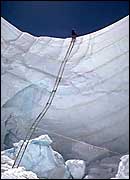 [click to zoom] (photo: Burleson/ Alpine Ascents) |
It's always a little frightening. It creaks; it moves; it wobbles. If you've ever been on a long ladder, it vibrates back and forth, so every time you take a step, it'll swing left or swing right, and then it starts vibrating in and out. As you get right in the middle of it, it's a heck of a ride. It's... scary.
— Todd Burleson, Alpine Ascents '97 Everest Expedition Leader
![]()
 Buckland |
The Icefall is supposed to be terrifying, and I suppose it is, but it's also the most spectacular, fascinating and weird environment I've ever encountered.
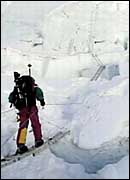 [click to zoom] (photo: Burleson/ Alpine Ascents) |
Blocks of ice as big as four-story houses must be climbed by primitive steps in the ice, or by aluminum ladders tied together, or circumnavigated though upward spiraling valleys. Gloomy, ice-blue, and I confess, fearful.
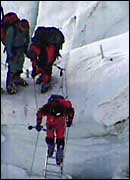 [click to zoom] (photo: Burleson/ Alpine Ascents) |
— Leslie Buckland, Climber
![]()
 Berg |
We get a 4:30am start through the Icefall. Get to the point that is always called the "Crampon Plain" or "Crampon Point" where you actually put the
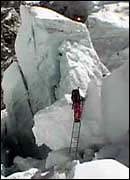 [click to zoom] (photo: Burleson/ Alpine Ascents) |
I'm a guide who's made a lot of trips through there, and maybe I've gotten a little jaded or used to it, but from a mountaineers perspective, the more you know about the way big pieces of ice can behave and move, the more terrifying a place like the upper third of the Icefall can be.
— Wally Berg, Climbing Guide